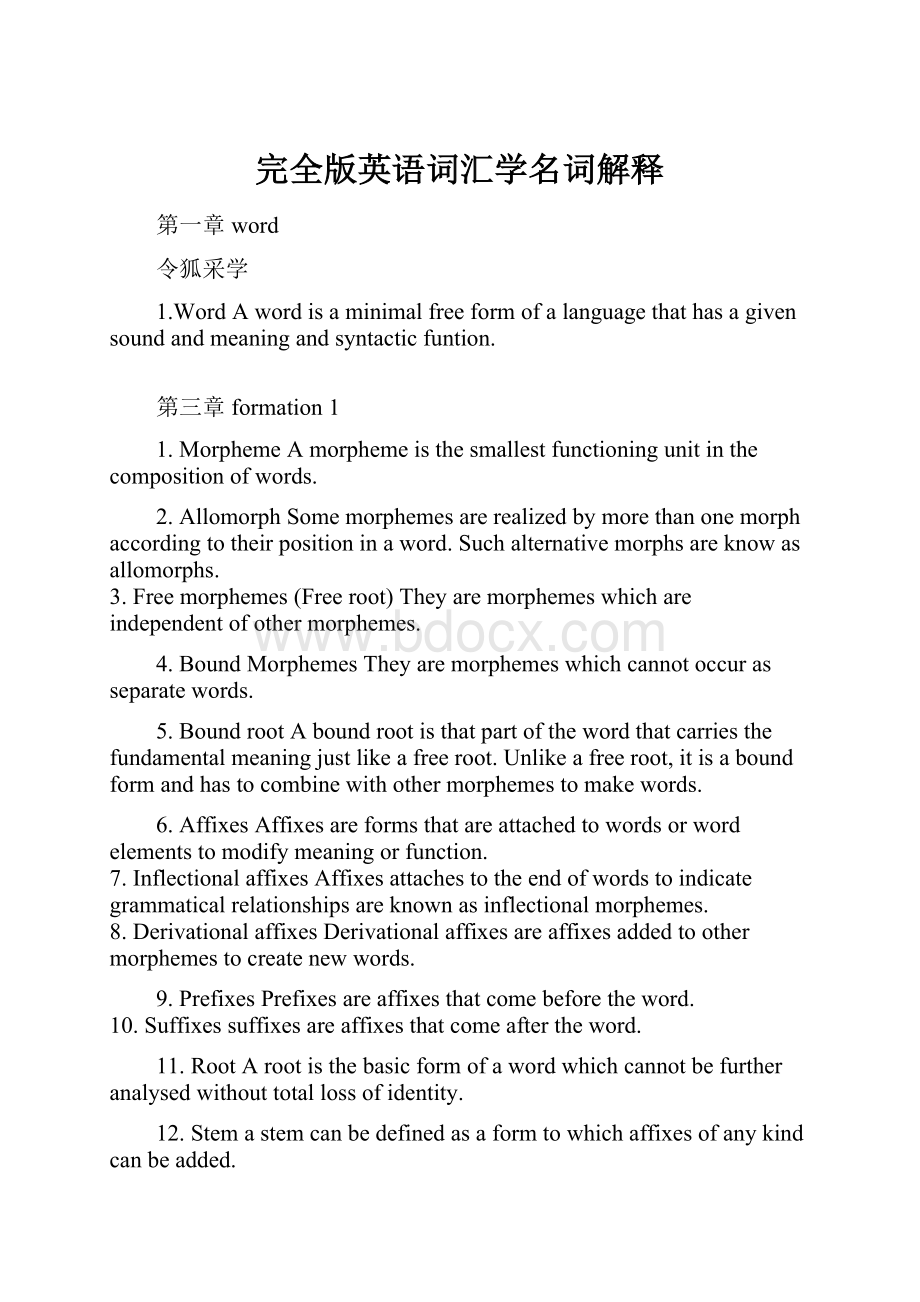完全版英语词汇学名词解释.docx
《完全版英语词汇学名词解释.docx》由会员分享,可在线阅读,更多相关《完全版英语词汇学名词解释.docx(8页珍藏版)》请在冰豆网上搜索。

完全版英语词汇学名词解释
第一章word
令狐采学
1.WordAwordisaminimalfreeformofalanguagethathasagivensoundandmeaningandsyntacticfuntion.
第三章formation1
1.MorphemeAmorphemeisthesmallestfunctioningunitinthecompositionofwords.
2.AllomorphSomemorphemesarerealizedbymorethanonemorphaccordingtotheirpositioninaword.Suchalternativemorphsareknowasallomorphs.
3.Freemorphemes(Freeroot)Theyaremorphemeswhichareindependentofothermorphemes.
4.BoundMorphemesTheyaremorphemeswhichcannotoccurasseparatewords.
5.BoundrootAboundrootisthatpartofthewordthatcarriesthefundamentalmeaningjustlikeafreeroot.Unlikeafreeroot,itisaboundformandhastocombinewithothermorphemestomakewords.
6.AffixesAffixesareformsthatareattachedtowordsorwordelementstomodifymeaningorfunction.
7.InflectionalaffixesAffixesattachestotheendofwordstoindicategrammaticalrelationshipsareknownasinflectionalmorphemes.
8.DerivationalaffixesDerivationalaffixesareaffixesaddedtoothermorphemestocreatenewwords.
9.PrefixesPrefixesareaffixesthatcomebeforetheword.
10.Suffixessuffixesareaffixesthatcomeaftertheword.
11.RootArootisthebasicformofawordwhichcannotbefurtheranalysedwithouttotallossofidentity.
12.Stemastemcanbedefinedasaformtowhichaffixesofanykindcanbeadded.
第四章formation2
1.Affixationaffixationisgenerallydefinedastheformationofwordsbyaddingwordformingorderivationalaffixestostems.
2.Prefixationistheformationofnewwordsbyaddingprefixestostems.
Suffixationistheformationofnewwordsbyaddingsuffixestostems.
3.Compounding(Compositon)istheformationofnewwordsbyjoiningtwoormorestems.
4.Conversionistheformationofnewwordsbyconvertingwordsofoneclasstoanotherclass.
5.Blendingistheformationofnewwordsbycombinedbypartsoftwowordsorawordplusaplusapartofanotherword.
6.Clippingistheformationofnewwordsbyshorteningalongerwordbycuttingapartofftheoriginalandusingwhatremaininstead.
7.Acronymyistheprocessofformingnewwordsbyjoiningtheinitiallettersofnamesofsocialandpoliticalorganizationsorspecialnounphrasesandtechnicalterms.
8.Backformationisaprocessofwordformationbywhichawordiscreatedbythedeletionofasupposedaffix.E.g.editorenteredthelanguagebeforeedit.
第五章meaning
1.Referencetherelationshipbetween language and the world.
2.Concept whichbeyondlanguage,is the result of human cognition,reflectingthe
objective world in the human mind.
3.Sense– denotes the relationship inside the language.
4.Motivationaccountsfortheconnectionbetweenthelinguisticsymbolanditsmeaning.
5.OnomatopoeicMotivationThesewordswerecreatedbyimitatingthenaturalsoundsornoises.
6.MorphologicalMotivationCompoundsandderivedwordsaremultimorphemicwordsandthemeaningofmanyarethesumtotalofthemorphemescombined.
7.SemanticMotivationreferstothementalassociationssuggestedbytheconceptualmeaningofaword.
8.EtymologicalMotivationThehistoryofthewordexplainsthemeaningoftheword
9.Grammatical meaning – refer to that part of the meaning of the word which indicates grammatical concept or relationships.
10.Lexical meaningis constant in all the words within or without context related to the notion that the word conveys.
11.Conceptual meaning (denotative meaning) – the meaning given in the dictionary and forms the core of wordmeaning
12.Associative meaning – the secondary meaning supplemented to the conceptual meaning. It is openended and indeterminate
13.Connotative meaning the overtones or association suggested by the conceptual meaning
14.Stylistic meaning – stylistic features make the words appropriate for different contexts.
15. Affective meaning – the speaker’s attitude towards the person or thing in question.
第六章SenseRelationsandsemanticField
23.Abbreviationincludesfourtypes:
I.ClippedwordsII.InitialismsIII.Acronyms
I.II.Initialismsarewordsformedfromtheinitiallettersofwordsandpronouncedasletters.E.g.IMF/aiemef/=InternationalMonetaryFund.
III.IV.Blendsarewordsthatarecombinedbypartsofotherword
12.OpaqueWordsWordsthatareformedbyonecontentmorphemeonlyandcannotbeanalysedintopartsarecalledopaquewords,suchasaxe,glove.
13.TransparentWordsWordsthatconsistofmorethanonemorphemesandcanbesegmentedintopartsarecalledtransparentwords:
workable(work+able),doorman(door+man).
14.MorphsMorphemesareabstractunits,whicharerealizedinspeechbydiscreteunitsknownasmorphs.Theyareactualspoken,minimalcarriersofmeaning.
15.AllomorpsSomemorphemesarerealizedbymorethanonemorphaccordingtotheirpositioninaword.Suchalternativemorphsareknownasallomorphs.Forinstance,themorphemeofplurality{s}hasanumberofallomorphsindifferentsoundcontext,e.g.incats/s/,inbags/z/,inmatch/iz/.
16.DerivationorAffixationAffixationisgenerallydefinedastheformationofwordsbyaddingwordformingorderivationalaffixestostems.Thisprocessisalsoknownasderivation.
17.Polysemy—thewordwithmorethanonesensesorwhichcanbeusedtoexpressmoremeaning.
18.Diachronicapproach–Diachronically,polysemyisassumedtobetheresultofgrowthanddevelopmentofthesemanticstructureofoneandsameword.Thisfirstmeaningistheprimarymeaning.Withtheadvanceoftimeandthedevelopmentoflanguage,ittookonmoreandmoremeanings.Theselattermeaningsarecalledderivedmeanings.
19.Synchronicapproach–synchronically,polysemyisviewedasthecoexistentofvariousmeaningofthesamewordinacertainhistoricalperiodoftime.Thebasicmeaningofawordisthecoreofwordmeaning.Thecoreofwordmeaningcalledthecentralmeaning(secondarymeaning).
20.Radiation–asemanticprocesswhichshowsthattheprimarymeaningstandsatthecenterandeachofthederivedmeaningsproceedoutofineverydirectionlikerays.
21.Concatenation–meaning“linkingtogether”,isthesemanticprocessinwhichthemeaningofawordmovesgraduallyawayfromitsfirstsensebysuccessiveshiftsuntil,inmanycases,thereisnotasignofconnectionbetweenthesensethatisfinallydevelopedandthatwhichtheternhadatthebegining.
22.Homonyms——aregenerallydefinedaswordsdifferentinmeaningbuteitheridenticalbothinsoundandspellingoridenticalonlyinsoundorspelling.
23.PerfectHomonyms——arewordsidenticalbothinsoundandspelling,butdifferentinmeaning.
24.Homographs——arewordsidenticalonlyinspellingbutdifferentinsoundandmeaning.
25.Homophones(mostcommon)——arewordsidenticalonlyinsoundbutdifferentinspellingandmeaning.
26.Synonyms—arewordsdifferentinsoundandspellingbutmostnearlyalikeorexactlythesameinmeaning.
27.AbsoluteSynonyms——arewords,whichareidenticalinmeaninginallitsaspects,i.e.bothingrammaticalmeaningandlexicalmeaning,includingconceptualandassociativemeanings.
28.Relativesynonyms——aresimilarornearlythesameindenotationbutembracedifferentshadesofmeaningordifferentdegreesofagivenquality.
29.Antonyms——arewordswhichareoppositeinmeaning.TypesofAntonyms(accordingtothesemanticopposition)
1)Contradictoryterms–theseantonymsaretrulyrepresentoppositenessofmeaning.Theyaresoopposedtoeachotherthattheyaremutuallyexclusiveandadmitnopossibilitybetweenthem.Theyassertionofoneisthedenialoftheother.
2)Contraryterms——ascalerunningbetweentwopolesorextremes.
3)Relativeterms–consistofrelationaloppositeness.Thepairsofwordsindicatesuchasocialrelationshipthatoneofthemcannotbeusedwithoutsuggestingtheother,thetypeisalsoreverseterms.Thetwowordsofeachpairinterdependent.
.Hyponymy——dealswiththerelationshipofsemanticinclusion.Thatis,themeaningofamorespecificwordisincludedinthatofanothermoregeneralword.
Thesespecificwordsareknownashyponyms(下义词).Forinstance,tulipandrosearehyponymsofflower.Thegeneralwordfloweristhesuperordinateterm(上义词)andthespecificonestulipandrosearethesubordinateterms(下义词).
第七章changesinwordmeaning
1.Extension(generalization)——Itisaprocessbywhichawordwithaspecializedsenseisgeneralizedtocoverabroaderorlessdefiniteconcept.
2.Narrowing(specialization)——Itisaprocessbywhichawordofwidemeaningacquiresanarrowerorspecializedsense.
3.Elevationoramelioration——referstotheprocessbywhichwordsrisefromhumblebeginningstopositionsofimportance.
4.Degradationorpejorationofmeaning——Itisaprocesswherebywordsofgoodoriginfallintoillreputationornonaffectivewordscometobeusedinderogatorysense.
5.Transfer——Itisaprocessbywhichaworddenotingonethingchangestorefertodifferentbutrelatedthing.
第八章context
Theextralinguisticcontextmayextendtoembracetheentireculturebackground.
Linguisticcontextcanbesubdividedintolexicalcontextandgrammaticalcontext
LexicalContext–referstothewordsoccurtogetherwiththewordinquestion.
Grammaticalcontext–Themeaningsofawordmaybeinflectedbythestructureinwhichitoccurs.
第九章:
idioms
1.Idiom—idiomsconsistofsetphrasesandshortsentences,whicharepeculiartothelanguageinquestionandloadedwiththenativeculturesandideas.
2.Characteristicsofidioms
a.SemanticunityIdiomseachconsistofmorethanoneword,buteachisasemanticunity.Thoughthevariouswordswhichmakeuptheidiomhavetheirrespectiveliteralmeanings,intheidiomtheyhavel